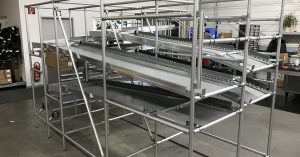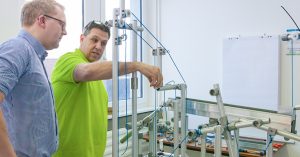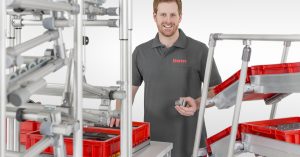A large-scale application demonstrates the effectiveness of Karakuri/LCA in automotive manufacturing at TPCA.
Toyota Peugeot Citroën Automobile Czech (TPCA), based in Kolín in the Czech Republic, is a joint venture between Toyota and Peugeot Société Anonyme (PSA) that was founded in 2002. The Kolín plant, which uses the Toyota Production System, manufactures the Toyota Aygo, Peugeot 108 and Citroën C1 small car models for the European market. A solution from item based on Karakuri/LCA (= Low Cost Automation) is used for transporting air conditioning units to the production line. Previously, TPCA used transport trolleys to bring the necessary air conditioning units to the production line. However, with that solution, these trolleys crossed the routes used by tugger trains, which meant the trains often had to stop. This interrupted the material flow, which in turn affected the value creation process. An alternative resulting in optimised workflows and greater productivity was therefore urgently needed.

The world of lean production
Less waste and more added value – lean production methods let you make targeted improvements to your production efficiency. Our white paper provides a concise introduction.
GET YOUR COPY NOW
Karakuri/LCA bridge with impressive dimensions
There were two reasons why TPCA turned to item to meet this challenge. Firstly, it had already successfully worked with profile and fastening technology from item in the past. Secondly, we have many years of experience in implementing Karakuri/LCA applications. This involves a form of automation based solely on the laws of gravity and mechanics. The Karakuri/LCA bridge now responsible for transporting air conditioning units consists of components from Profile Tube System D30 and is 6 metres long, 6 metres wide and 5 metres high. It was designed collaboratively and incorporates numerous suggestions from TPCA. The TPCA employees involved were also given advanced training in item fastening technology. Materials are supplied via a shooter. Placed into small load carriers (SLCs), the air conditioning units are lifted up the loading tower by a linear axis. Roller conveyors then carry them from one side of the transport bridge to the other over the tugger train route below.
Sometimes it has to be hybrid Karakuri/LCA
Yet the combination of Karakuri/LCA and linear technology is by no means a contradiction in terms, as our lean production expert Stefan Armbruster points out in an interview: “Low-cost automation uses a combination of muscle power, leverage and gravity. All the same, there’s no getting around the laws of physics. If there is no other solution, you have to revert to traditional drives. In fact, that’s often essential when it comes to lifting heavy loads or moving loads very high up. One typical case is when components need to be lifted over logistics routes to get to the workstation.” And this is exactly the situation here. That’s why the TPCA bridge is a hybrid Karakuri/LCA. Would you like to know more about Karakuri/LCA? You can deepen your knowledge in a special online training at the item Academy.
On the other side of the Karakuri/LCA bridge, the units are turned 90 degrees. After a distance of 3 metres, the load reaches a second tower, where it is lowered by purely mechanical means and can then be removed for further processing. The empty SLCs move into a third tower, where a linear unit lifts them up. They are initially stacked in this tower, before roller conveyors then take them back over the tugger train route in stacks of four. The stacked SLCs are brought back down to ground level in the fourth and final tower and can now be removed and filled with new units. This customised and impressively sized Karakuri/LCA solution is a high-precision system that enables users to eliminate the wastage of time and resources.
Are you interested in fascinating reports and innovations from the world of lean production? Then we have just what you’re looking for! Simply subscribe to the item blog by completing the box at the top right.





